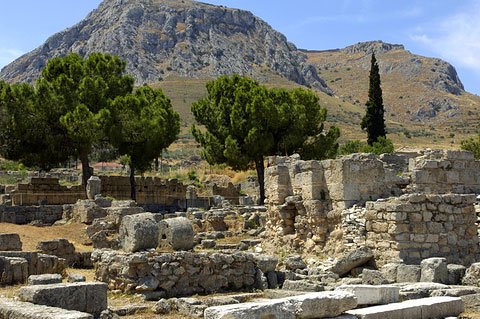As with most ancient cities, Corinth history tells us that the importance of the city was due to the location. The city grew in an area which controlled the only land access to the Peloponnese from the north.
Although sea travel could be dangerous, the mountainous nature of Greece made trade by land almost impossible. As goods were traded with countries all over the Mediterranean, Corinth was in a unique position, and had two harbours. Lechaion controlled the Gulf of Corinth, while Kenchreai controlled access to the Aegean.
Since the sixth century BC they also had a road between the two ports upon which whole ships were pulled on carts. This continued through the Roman era. The canal was not dug until 1891/1893. Now in 2020 work as started to reclaim this road called the Diolkos.

Early years
After the Dorian invaders settled in around 1000BC, the city began to develop. It became prosperous under the Bacchiad dynasty from the middle of the 8th C BC.
Periander is famous in Corinth history. Although he was renowned for his cruelty, he was also considered to be one of the seven sages of Greece. He made the city wealthy by imposing large taxes on goods passing across the isthmus.
Local resources
Corinth history must include the local resource of clay. The Corinthians used it to develop their pottery, which was know and sought after throughout the ancient world. They used the clay to make ceramic vases and pots. The clay was very fine, and they were able to produce very delicate objects.
They were also creative in other ways. They developed the production of bronze objects, glass and purple dyes for cloth. (Purple dyes were extracted from foul-smelling snails.)
Colonies
Like many other Greek states, Corinth established colonies, included Corfu and Syracuse in Sicily. This enabled them to develop trading links, and so helped with their exports.
In the 5th C BC Athens became the dominant power in the region. But after the war between Athens and Sparta (which Sparta won), Corinth took back some of her influence as one of the Greek cities in the “League of Corinth” under the leadership of Philip of Macedon and his son Alexander the Great.

Plan
This plan shows the main structures which have been excavated in ancient Corinth. As you will see, most of them are from the Roman era.
This schematic map contains additional content and photos.
Click on grey shapes or blue markers for name and description. Click on pale symbol markers for photos.
Try the enlarged view and the satellite view (found at bottom of pop-up menu).
Corinth history – decline and fall
Corinth history tells us that due to earthquakes and invasions the city lost its importance. The earthquake of 521 AD completely destroyed the city, and only a small settlement grew up on the site of the old agora in the 10th C AD. Trade bypassed it, and Corinth never regained its former status, whether under the rule of the Franks, the Venetians or the Turks.